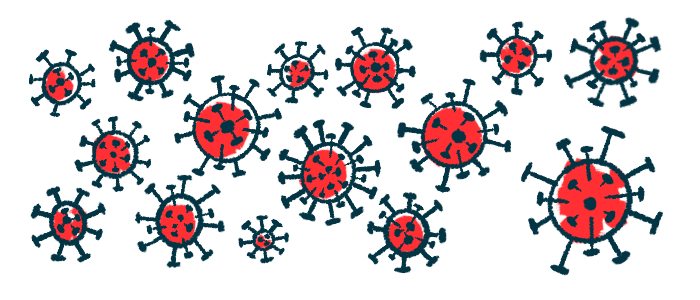CFTR Mutations Impair SARS-CoV-2 Virus, Study Finds
Cystic fibrosis-related mutations may protect against severe COVID-19

CFTR gene mutations — the cause of cystic fibrosis (CF) — significantly reduce the cell entry and replication of SARS-CoV-2, the virus responsible for COVID-19, a new study reports.
This protective effect was due to the link between the CFTR protein channel and angiotensin-converting enzyme 2 (ACE-2), a protein used by SARS-CoV-2 as a point of entry into a cell. CFTR expression (activity) was associated with ACE-2 levels, and both proteins shared a high degree of colocalization, meaning both were consistently found together in the cells.
Furthermore, cells from CF patients did not release high levels of the pro-inflammatory interleukin-6 (IL-6, a type of small protein called cytokine) in response to SARS-CoV-2, which is a feature of COVID-19 infection and has been linked to more severe COVID-19.
“Overall, this study clarifies why CF condition, despite being potentially considered a comorbidity [co-existing condition] for COVID-19, is not associated with particularly severe outcome upon SARS-CoV-2 infection,” the research team wrote.
The study, “SARS-CoV-2 viral entry and replication is impaired in Cystic Fibrosis airways due to ACE2 downregulation,” was published in the journal Nature Communications.
Previous research provided evidence that cells with CFTR mutations had lower viral load and lower ACE-2 expression after SARS-CoV-2 infection than cells with wild-type (healthy) CFTR. However, the mechanisms underlying these findings were still unclear.
CF is caused by mutations in the CFTR gene that is responsible for the production of the CFTR protein. This protein works like a gate or channel in the cell membrane, helping to regulate the flow of water and salts. CFTR mutations can lead to the production of dysfunctional CFTR or no CFTR production at all.
The research team, from Italy, noted that several studies have suggested that incidence of severe COVID-19 in CF patients is lower than what was expected, although those with severe disease or a lung transplant may still have a high risk of severe COVID-19 outcomes. Because of this, the team set out to uncover the cellular mechanisms that could explain this situation.
They first assessed whether CF and CFTR mutations were associated with ACE-2. SARS-CoV-2 enters cells by binding to ACE-2 using the viral spike protein. ACE-2 can be located at the cell membrane and is widely distributed in the body’s tissues, including in cells from the lining (or epithelium) of the lungs.
ACE2 levels were low in cells from the epithelium of the nose and bronchi (the main lung airways) of CF patients compared with cells from healthy individuals. To investigate if these low ACE2 levels were linked to CFTR dysfunction in CF, the team used several bronchial epithelial cell models genetically edited to alter the expression of CFTR.
In cells with impaired CFTR expression, ACE2 levels were reduced up to 19% compared with those in cells with normal CFTR expression. In contrast, cells with overexpression of the normal, or wild-type, CFTR had substantially increased ACE2 levels, with the same happening in cells overexpressing F508del-mutated CFTR, the most common CF-causing mutation.
Taken together, these results show that ACE2 levels are associated with CFTR expression, but seemingly not regulated by CFTR function, because the F508del mutation impairs the proper functioning of this protein.
The distributions of ACE2 and CFTR in the cell also were found to be tightly linked in experiments using immunofluorescent single-cell analysis, a technique that allows the visualization and quantification of fluorescence-marked proteins in the cell. In cells expressing wild-type CFTR, both proteins were colocalized in the cell membrane, which did not happen in cells not expressing CFTR.
Furthermore, in cells overexpressing F508del-mutated CFTR, the location of both CFTR and ACE2 was restricted to the endoplasmic reticulum, the organelle where proteins are made. This is consistent with the effect of the F508del mutation, which leads to an unfolded CFTR protein that is retained in the endoplasmic reticulum, and another strong indication that ACE2’s localization is linked to CFTR.
A similar situation was observed in tissue samples of human bronchial epithelium. Tissue from healthy individuals showed ACE2 and CFTR localized at the cell membrane, but the same was not observed in tissue from a CF patient with a F508del mutation and one with a class 1 mutation (more severe CF).
“These results therefore support the hypothesis that the presence of a mutated CFTR channel, as well as the loss of CFTR expression, may induce mislocalization of the ACE2 receptor,” the researchers wrote.
SARS-CoV-2 infection
Next, the team focused on the role of CFTR in SARS-CoV-2 infection. They observed that viral replication in the first 72 hours was significantly higher in human bronchial epithelial cells with normal CFTR expression than in those with no CFTR production. Similarly, SARS-CoV-2 infection and replication were substantially reduced in a different lung cell line by pharmacologically inhibiting CFTR function and by inhibiting CFTR expression using microRNA molecules.
The binding of SARS-CoV-2’s spike protein to ACE2 also was impaired significantly in cells not expressing CFTR compared with cells with F508del-mutated CFTR and cells with wild-type CFTR.
Finally, the researchers assessed whether CF affects the SARS-CoV-2-induced release of high levels of IL-6. They did this because a recent study showed that immune cells called macrophages from CF patients released less IL-6 than cells from healthy individuals in response to SARS-CoV-2’s spike protein.
Nose and bronchial epithelial cells from CF patients with F508del mutation showed reduced IL-6 expression levels, compared with cells from healthy donors. When cells were stimulated with SARS-CoV-2’s spike protein, IL-6 levels dramatically increased in cells from healthy donors. However, cells from CF patients had a much weaker response.
“Our results suggest that CF condition may hamper the [cytokine release syndrome] triggered by SARS-CoV-2 S protein stimulation in airway epithelia, thus strengthening the hypothesis that CF may constitute a biological advantage by decreasing the risk of developing unfavorable COVID-19 outcomes,” the researchers wrote. They added “this work suggests that CFTR and possibly other chloride channels could be taken into consideration as molecular targets for the development of alternative anti-COVID-19 therapies.”









